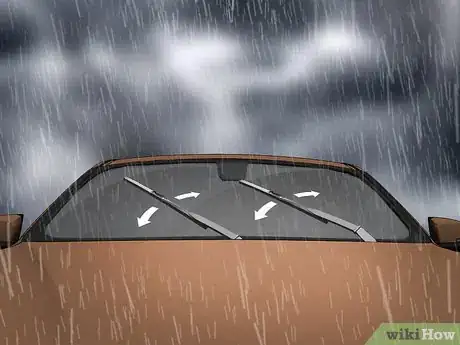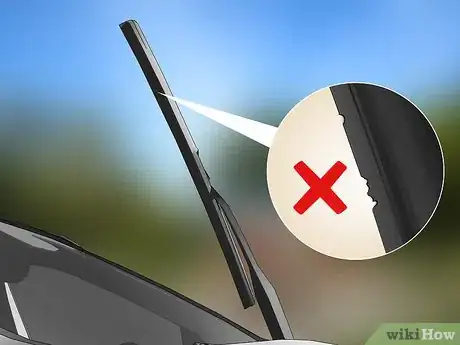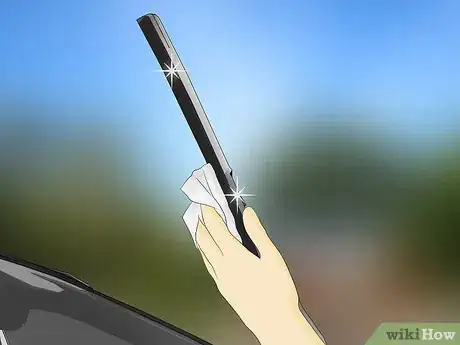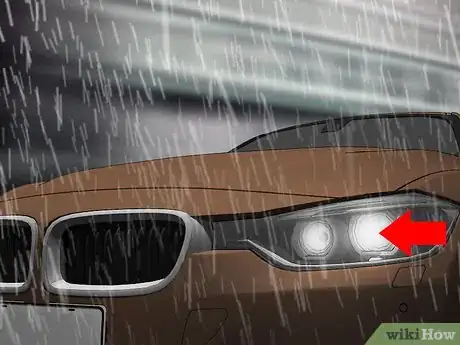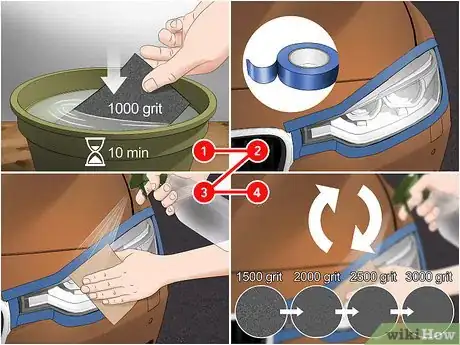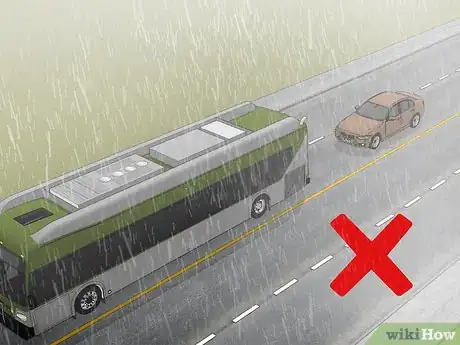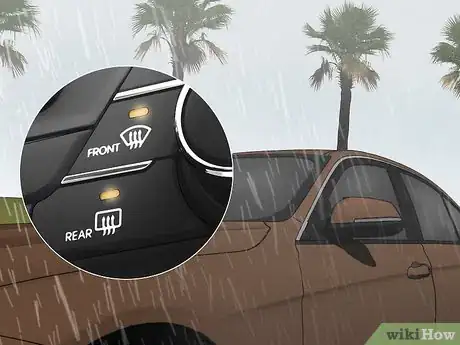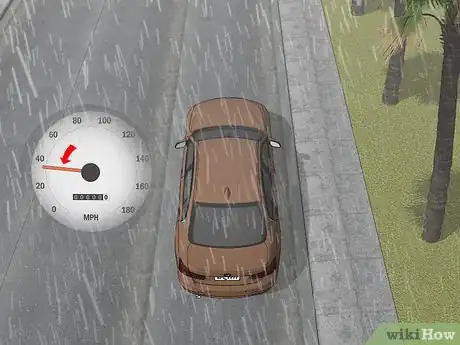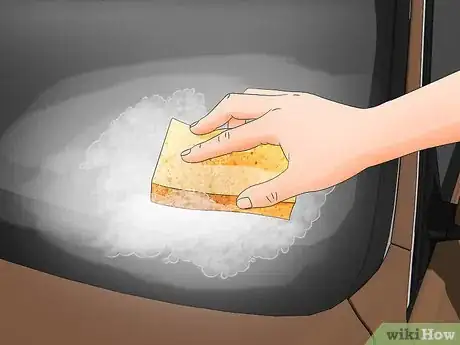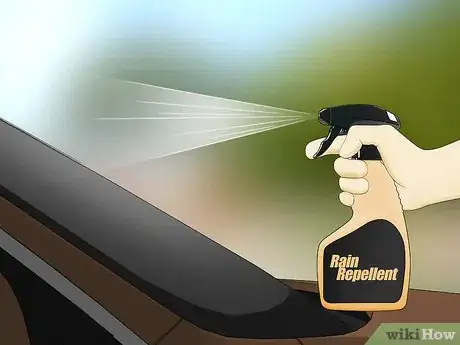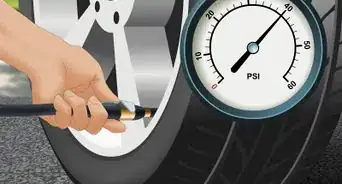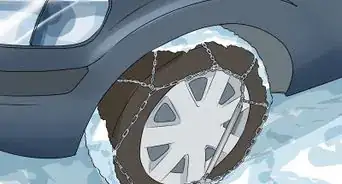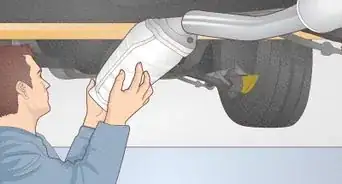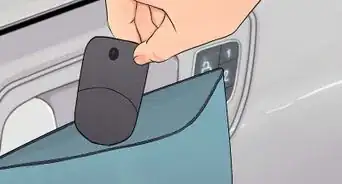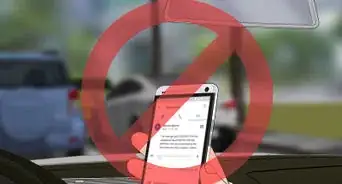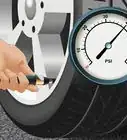This article was co-authored by Simon Miyerov. Simon Miyerov is the President and Driving Instructor for Drive Rite Academy, a driving academy based out of New York City. Simon has over 8 years of driving instruction experience. His mission is to ensure the safety of everyday drivers and continue to make New York a safer and efficient driving environment.
There are 11 references cited in this article, which can be found at the bottom of the page.
This article has been viewed 69,401 times.
Driving in the rain, especially after dark, can cause dramatic declines in visibility. The best ways to improve driving visibility in the rain are to turn on your headlights and your windshield wipers. Stay away from large vehicles that leave a large spray in their wake. Keep your headlights clean and clear, and change windshield wipers that are aged or deteriorating.
Steps
Using and Maintaining Your Wipers
-
1Turn your windshield wipers on. Unless your car comes with automatic wipers, you’ll need to manually activate your windshield wipers to improve driving visibility in the rain. Windshield wipers typically have three different settings: slow, medium, and fast. If the rain is light, select the slow speed. If the rain is heavier (and your visibility is poorer), select a faster speed.[1]
- If you wish, you could use the high speed in low levels of rain, but it is not necessary.
- There is no objective criteria for determining whether you need a faster or slower wiper speed when driving in the rain. Using your best judgment, select the wiper speed that most closely corresponds to the rain’s intensity at any given time.
- If you have a rear windshield wiper, activate it, too.
-
2Change old or brittle wiper inserts. The windshield wiper consists of two parts: the rubber wiper insert that swipes across the windshield and the metal blade that actually holds it. Check your wiper inserts regularly for stiffness or cracks, and replace them if you detect any.[2] Most windshield wiper inserts will need to be changed at least once every three years to improve visibility in rain.[3]
- Consult your owner’s manual or an auto parts store for information regarding the type and size of wiper blades you need.
- Generally, wiper inserts can simply be slid into and out of the metal blade itself.
- If you regularly park your car outside, you’ll probably have to replace your windshield wipers more often than if you park in the garage.
Advertisement -
3Replace windshield wiper blades as needed. If your wiper blades are rusty, bent, or corroded, replace them, too. Use high-quality wiper blades, preferably ones coated with a rain repellent.[4]
- If there are areas of your windshield that do not get properly wiped when you use your wipers, you’ll know that the wiper is bent or applying uneven pressure to the windshield.
- Generally, wiper blades can simply be unsnapped from the metal arm that holds the blade, then a new blade can be snapped in.
- Consult your owner’s manual or your local auto parts store for information regarding the sort of wiper blades you need.
-
4Keep your wiper blades clean. Dirty windshield wiper blades can cause streaking and water beading. To clean your wiper blades, soak a lint-free cloth or paper towel in windshield washer fluid. Wipe the cloth or paper towel along the length of the blades. Turn the cloth or paper towel over as needed to ensure you’re always wiping the blades with a clean area.
Using and Cleaning Your Headlights
-
1Turn on your headlights. If you’re driving in the rain on an overcast day or at night, your headlights can help you increase visibility. Even if you’re driving in rain during the day, turning your headlights on is a good idea since it allows other vehicles to see you.[5]
- Many headlights have different settings. Choose the correct one for the existing conditions.
- For instance, if you’re driving in light rain through a dark area, you might choose to use your brightest headlight setting.
- If you’re driving through fog as well as rain, use your fog lights.
-
2Wash your headlights. If your headlights are caked in grime or dirt, they will not shine as brightly as they should. This could reduce your visibility when driving in the rain. To keep your headlights shining properly, wash them with soapy water either on their own or when you wash your car.[6]
- There is no regular schedule according to which you must wash your headlights. If your headlights appear less luminous than they previously were, or if they’re visibly dirty, give them a wash.
-
3Scrub your headlights with sandpaper. For a deeper clean, soak a piece of 1000 grit wet/dry sandpaper in cold water. Apply painter’s tape to the area of around the perimeter of your headlights. After 10 minutes, lightly sand the headlights, moving in straight strokes from side-to-side. Spray the headlight with water while you work.[7]
- Repeat the procedure using 1500 grit sandpaper, then 2000 grit, 2500 grit, and 3000 grit wet/dry sandpaper.
- Alternate the direction of your scrubbing each time. For instance, if you moved side-to-side with one piece of sandpaper, use an up-and-down scrubbing method for the next.
- When the discoloration, dirt, and scratches on the headlight are gone, move on to the next level of sandpaper.
- There is no regular schedule according to which you must engage in deep cleaning of your headlights. Give your headlights a deep cleaning with sandpaper if washing your headlights using the standard method produces inadequate results.
Taking Additional Measures
-
1Don’t follow trucks or buses closely. The spray produced by these large vehicles will decrease your visibility in rain. Try to keep several car lengths away from trucks and buses.[8]
- If you need to pass trucks or buses, do so quickly so as to minimize the time you spend behind or beside them, where you can experience significant spray.
-
2Put on some polarized glasses. If you’re driving through rain during the day, put on a pair of polarized sunglasses to increase your driving visibility. If you’re driving in rain at night, you will not be able to increase driving visibility by wearing polarized sunglasses.[9]
-
3Turn on the demisters if necessary. If the temperature of the rain and the temperature inside your vehicle are too different, your windows might fog over. To combat this and increase visibility when driving in the rain, turn on the demisters.[10]
-
4Slow down. Slowing your speed can give you extra time to see what’s ahead. You should be able to see the space you’ll be driving through at least 12 seconds before you pass through it. When driving in the rain, adjust your speed to meet this visibility standard.[11]
-
5Clean your windshield. Sometimes your windshield wipers are not strong enough to wipe away all the grime on your windshield. Dirt stuck to the top corners, especially, could dribble down during a rainstorm. The best way to get your windshield clean is to have it cleaned by a professional at your local auto wash. Alternately, you could soak a cloth or sponge in soapy water and wipe it across the windshield until the entire surface is clean.[12]
- Clean your windshield when it is dirty.
- Don’t forget to clean your windshield wiper blades, too.
-
6Apply a coat of rain repellent to your windshield. Rain repellents will prevent rain from beading on your windshield. Instead, rain will roll smoothly off the windshield upon contact. Specific directions for use vary depending on the product you use. Generally, though, you can simply spray the repellent of your choice on the windshield, then wipe it away using a gentle circular motion.[13]
- Rain repellent solutions usually need to be applied once every six months.
Expert Q&A
-
QuestionHow should I drive during rush hour if it's raining?
 Simon MiyerovSimon Miyerov is the President and Driving Instructor for Drive Rite Academy, a driving academy based out of New York City. Simon has over 8 years of driving instruction experience. His mission is to ensure the safety of everyday drivers and continue to make New York a safer and efficient driving environment.
Simon MiyerovSimon Miyerov is the President and Driving Instructor for Drive Rite Academy, a driving academy based out of New York City. Simon has over 8 years of driving instruction experience. His mission is to ensure the safety of everyday drivers and continue to make New York a safer and efficient driving environment.
Driving Instructor It's important to drive with the flow of traffic while still keeping plenty of space between you and the other vehicles. It's a good idea to avoid changing lanes unless you absolutely have to, since you won't save much time anyway and you're only going to make traffic worse. Also, don't rubberneck while you're in traffic. That's what causes a lot of traffic in general. People get into a car accident, everyone starts rubbernecking, and the congestion just gets out of hand. Other than that, just take things slow and leave plenty of space between you and the other vehicles.
It's important to drive with the flow of traffic while still keeping plenty of space between you and the other vehicles. It's a good idea to avoid changing lanes unless you absolutely have to, since you won't save much time anyway and you're only going to make traffic worse. Also, don't rubberneck while you're in traffic. That's what causes a lot of traffic in general. People get into a car accident, everyone starts rubbernecking, and the congestion just gets out of hand. Other than that, just take things slow and leave plenty of space between you and the other vehicles. -
QuestionHow can I be an expert at driving?
 Community AnswerKnow what cars are surrounding you and where; it makes it much safer to switch lanes in a hurry if you know that there is a car in your blind spot and act accordingly. Stay calm no matter what is happening around you in the traffic or on the road; if you take a corner too fast or too slow just adjust your steering without panicking. Always go with the flow of the traffic, if the speed limit is 60 but every car around you is going about 70, then you need to go 70 as well; blocking the flow of traffic causes other cars to drive erratically, which is unsafe for them as well as you. These are just a few tips but practice makes perfect, keep practicing to get better and better.
Community AnswerKnow what cars are surrounding you and where; it makes it much safer to switch lanes in a hurry if you know that there is a car in your blind spot and act accordingly. Stay calm no matter what is happening around you in the traffic or on the road; if you take a corner too fast or too slow just adjust your steering without panicking. Always go with the flow of the traffic, if the speed limit is 60 but every car around you is going about 70, then you need to go 70 as well; blocking the flow of traffic causes other cars to drive erratically, which is unsafe for them as well as you. These are just a few tips but practice makes perfect, keep practicing to get better and better.
References
- ↑ https://www.drivingtests.co.nz/resources/29-driving-in-poor-visibility/
- ↑ http://www.smartmotorist.com/driving-guideline/tips-for-driving-in-rain.html
- ↑ http://www.popularmechanics.com/cars/how-to/a305/1789177/
- ↑ http://www.dummies.com/home-garden/car-repair/maintaining-your-wipers-and-washer-fluid/
- ↑ http://www.smartmotorist.com/driving-guideline/tips-for-driving-in-rain.html
- ↑ http://www.popularmechanics.com/cars/how-to/a10346/how-to-make-your-headlights-shine-like-new-16649941/
- ↑ http://www.popularmechanics.com/cars/how-to/a10346/how-to-make-your-headlights-shine-like-new-16649941/
- ↑ http://www.smartmotorist.com/driving-guideline/tips-for-driving-in-rain.html
- ↑ http://www.snopes.com/autos/techno/sunglasses.asp
- ↑ https://www.drivingtests.co.nz/resources/29-driving-in-poor-visibility/
- ↑ Simon Miyerov. Driving Instructor. Expert Interview. 4 December 2019.
- ↑ https://www.drivingtests.co.nz/resources/29-driving-in-poor-visibility/
- ↑ https://itstillruns.com/homemade-windshield-water-repellent-7526392.html
